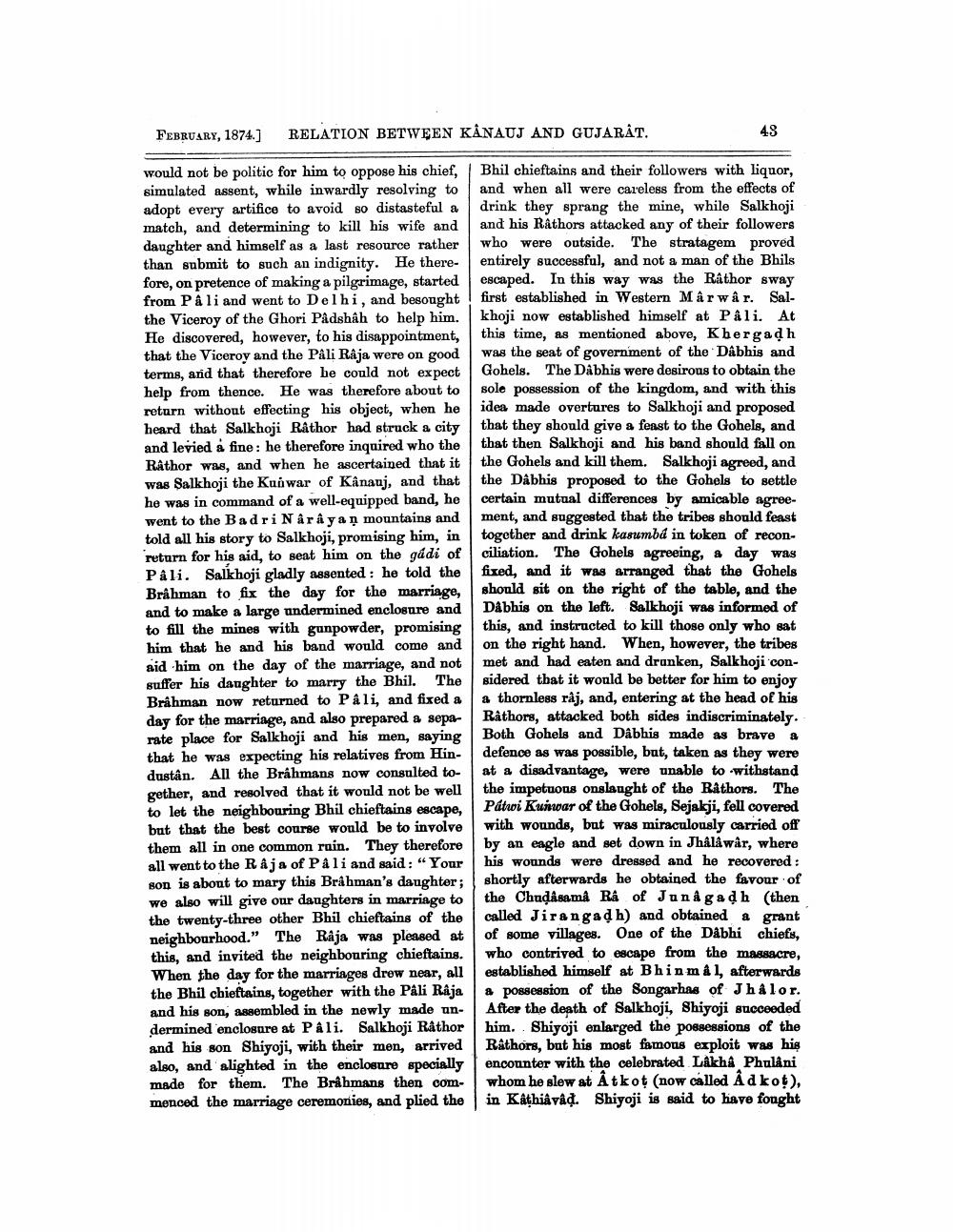________________
RELATION BETWEEN KANAUJ AND GUJARAT.
FEBRUARY, 1874.]
would not be politic for him to oppose his chief, simulated assent, while inwardly resolving to adopt every artifice to avoid so distasteful a match, and determining to kill his wife and daughter and himself as a last resource rather than submit to such an indignity. He therefore, on pretence of making a pilgrimage, started from P âli and went to Delhi, and besought the Viceroy of the Ghori Pâdshâh to help him. He discovered, however, to his disappointment, that the Viceroy and the Pâli Râja were on good terms, and that therefore he could not expect help from thence. He was therefore about to return without effecting his object, when he heard that Salkhoji Râthor had struck a city and levied a fine: he therefore inquired who the Rathor was, and when he ascertained that it was Salkhoji the Kunwar of Kânauj, and that he was in command of a well-equipped band, he went to the Badri Nârâyan mountains and told all his story to Salkhoji, promising him, in return for his aid, to seat him on the gádi of Pali. Salkhoji gladly assented: he told the Brahman to fix the day for the marriage, and to make a large undermined enclosure and to fill the mines with gunpowder, promising him that he and his band would come and aid him on the day of the marriage, and not suffer his daughter to marry the Bhil. The Brahman now returned to Pâli, and fixed a day for the marriage, and also prepared a separate place for Salkhoji and his men, saying that he was expecting his relatives from Hindustân. All the Brahmans now consulted together, and resolved that it would not be well to let the neighbouring Bhil chieftains escape, but that the best course would be to involve them all in one common rain. They therefore all went to the Raja of Pâli and said: "Your son is about to mary this Brâhman's daughter; we also will give our daughters in marriage to the twenty-three other Bhil chieftains of the neighbourhood." The Raja was pleased at this, and invited the neighbouring chieftains. When the day for the marriages drew near, all the Bhil chieftains, together with the Pâli Râja and his son, assembled in the newly made undermined enclosure at Pâli. Salkhoji Rathor and his son Shiyoji, with their men, arrived also, and alighted in the enclosure specially made for them. The Brahmans then commenced the marriage ceremonies, and plied the
48
Bhil chieftains and their followers with liquor, and when all were careless from the effects of drink they sprang the mine, while Salkhoji and his Râthors attacked any of their followers who were outside. The stratagem proved entirely successful, and not a man of the Bhils escaped. In this way was the Râthor sway first established in Western Mârwâr. Salkhoji now established himself at Pâli. At this time, as mentioned above, Khergaḍh was the seat of government of the Dâbhis and Gohels. The Dâbhis were desirous to obtain the sole possession of the kingdom, and with this idea made overtures to Salkhoji and proposed that they should give a feast to the Gohels, and that then Salkhoji and his band should fall on the Gohels and kill them. Salkhoji agreed, and the Dabhis proposed to the Gohels to settle certain mutual differences by amicable agreement, and suggested that the tribes should feast together and drink kasumba in token of reconciliation. The Gohels agreeing, a day was fixed, and it was arranged that the Gohels should sit on the right of the table, and the Dabhis on the left. Salkhoji was informed of this, and instructed to kill those only who sat on the right hand. When, however, the tribes met and had eaten and drunken, Salkhoji considered that it would be better for him to enjoy a thornless raj, and, entering at the head of his
Râthors, attacked both sides indiscriminately. Both Gohels and Dâbhis made as brave a defence as was possible, but, taken as they were at a disadvantage, were unable to withstand the impetuous onslaught of the Râthors. The Patwi Kunwar of the Gohels, Sejakji, fell covered with wounds, but was miraculously carried off by an eagle and set down in Jhâlâwâr, where his wounds were dressed and he recovered: shortly afterwards he obtained the favour of the Chudasama Râ of Junagadh (then called Jirangadh) and obtained a grant of some villages. One of the Dabhi chiefs, who contrived to escape from the massacre, established himself at Bhinmal, afterwards a possession of the Songarhas of Jhâlor. After the death of Salkhoji, Shiyoji succeeded him. Shiyoji enlarged the possessions of the Rathors, but his most famous exploit was his encounter with the celebrated Lakha Phulani whom he slew at Atkot (now called Adkot), in Kathiâvâd. Shiyoji is said to have fought




